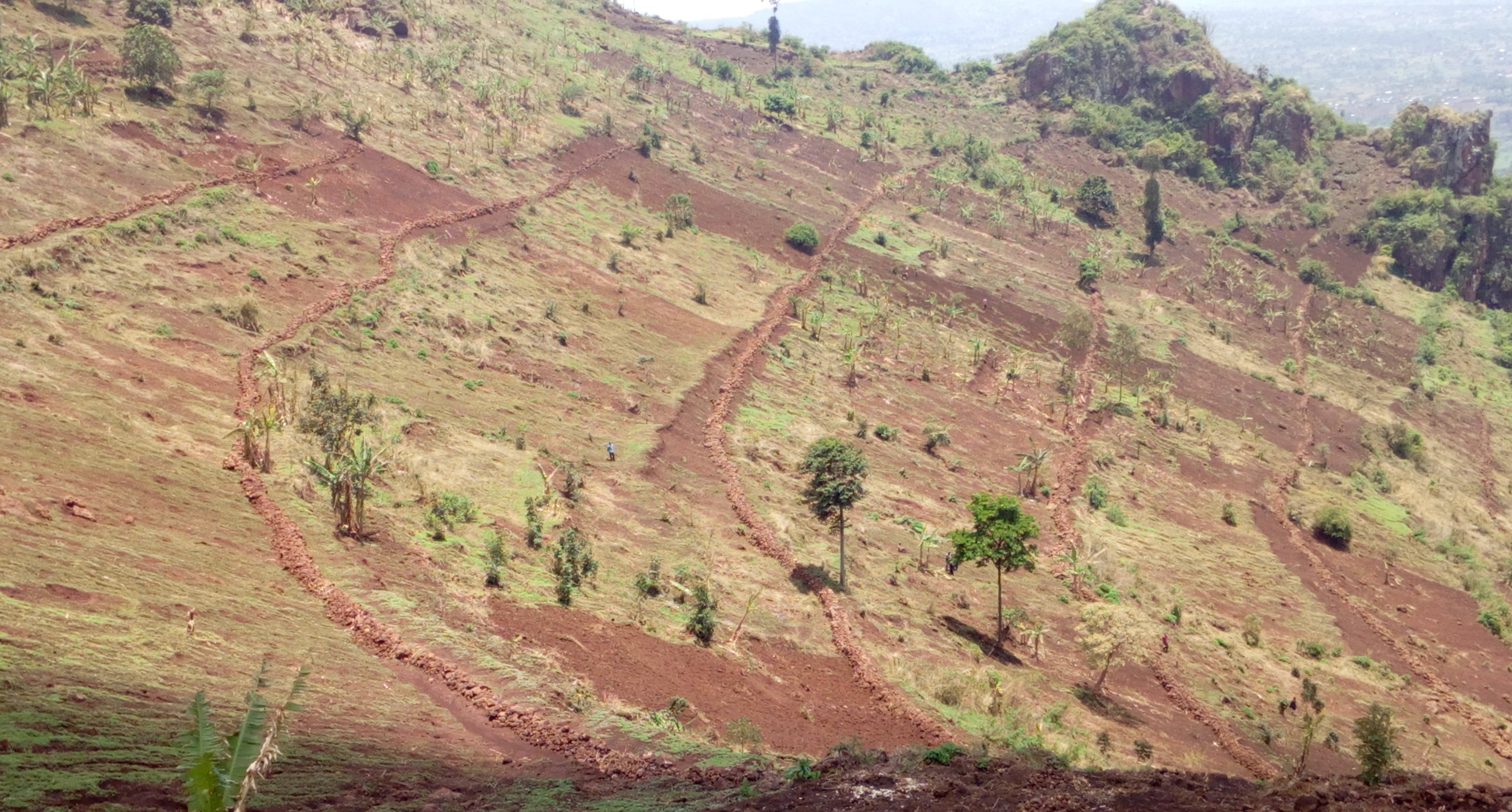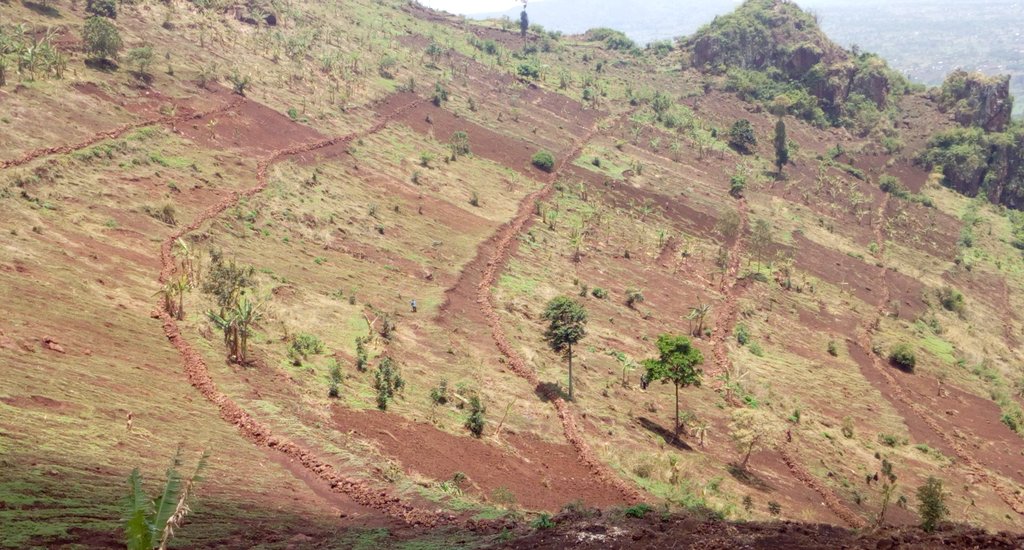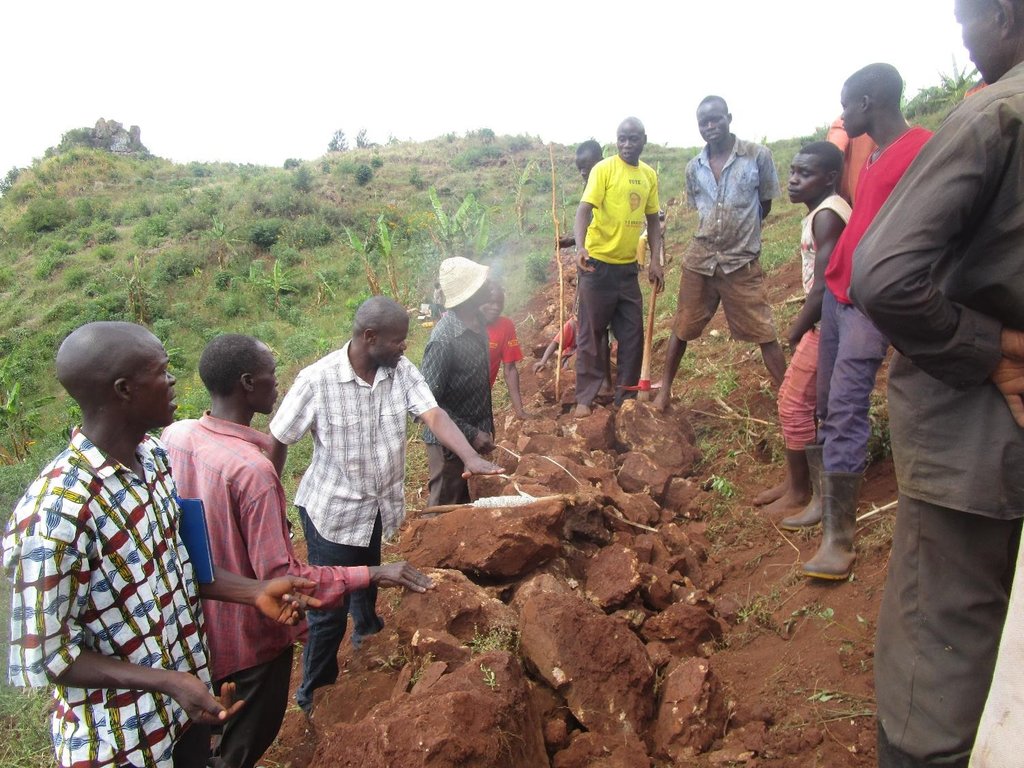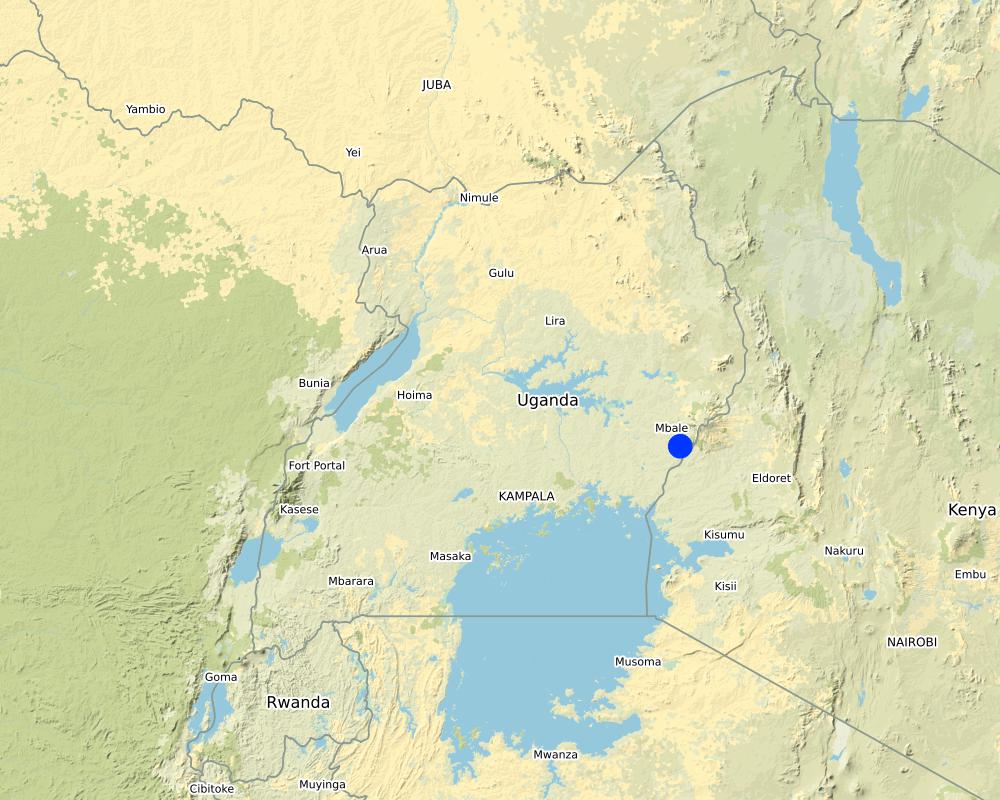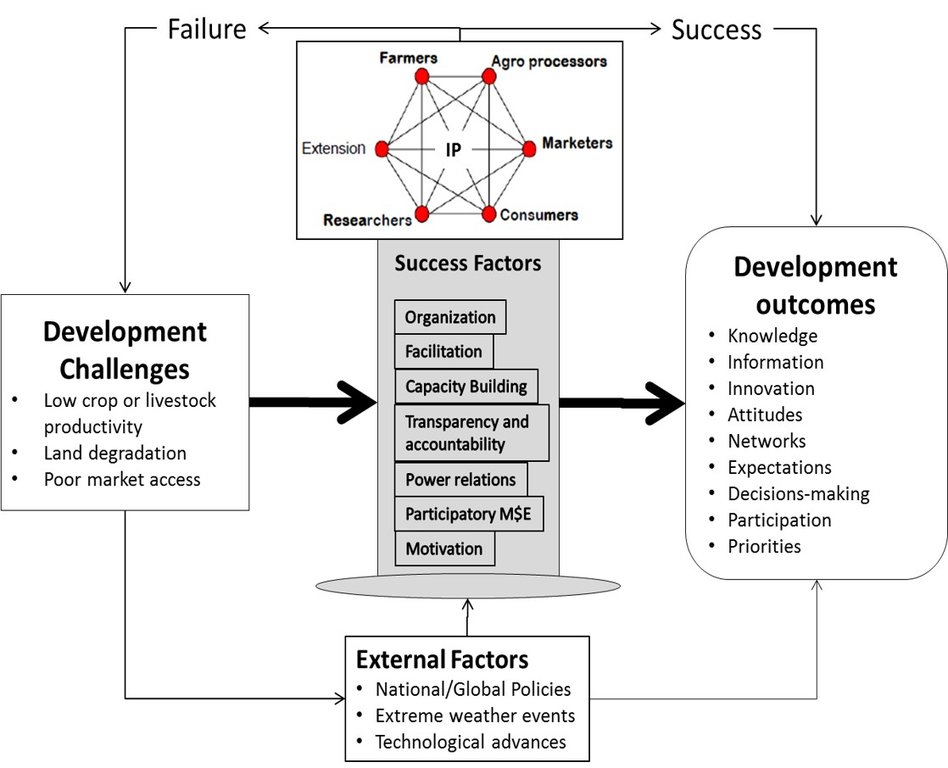Innovation Platform Approach (IPA) for Collective Action in SLM [Uganda]
- Criação:
- Atualização:
- Compilador/a: Bernard Fungo
- Editores: Dr. Patrick Musinguzi, Moses Makooma Tenywa, Kamugisha Rick Nelson
- Revisores: Nicole Harari, Udo Höggel
Tubaana Group
approaches_4041 - Uganda
Veja as seções
Expandir tudo Recolher tudo1. Informação geral
1.2 Detalhes do contato das pessoas capacitadas e instituições envolvidas na avaliação e documentação da abordagem
Nome do projeto que facilitou a documentação/avaliação da Abordagem (se relevante)
Scaling-up SLM practices by smallholder farmers (IFAD)Nome da(s) instituição(ões) que facilitou(ram) a documentação/avaliação da Abordagem (se relevante)
Uganda Landcare Network (ULN) - Uganda1.3 Condições em relação ao uso da informação documentada através de WOCAT
Quando os dados foram compilados (no campo)?
12/09/2016
O/a compilador/a e a(s) pessoa(s) capacitada(s) aceitam as condições relativas ao uso de dados documentados através da WOCAT:
Sim
2. Descrição da abordagem de GST
2.1 Descrição curta da abordagem
Critical actors in a certain area come together, articulate the perceived challenge, identify solutions, allocate responsibilities and work together towards overcoming the challenge
2.2 Descrição detalhada da abordagem
Descrição detalhada da abordagem:
Efficient use of natural resources is a critical pathway to achieving green growth. Mountain ecosystems are an example of natural resources that need to be sustainably managed to continue providing economic, social and environmental benefits to the large number of dependent communities. The challenge is that these ecosystems are fragile and highly susceptible to natural disasters and their management requires multi-sectoral, transboundary, interdisciplinary and landscape level interventions. Although several technologies to address land degradation exist, adoption remains low. This has been attributed mainly to a dysfunctional extension system and weak implementation of land management policies/regulations. Working at landscape-scale and ensuring inter-sectoral coordination and cooperation is crucial for effective land management responses.
An Innovation Platform (IP) approach is a mechanism to enhance communication and innovation capacity among mutually dependent actors, by improving interactions, coordination, and coherence among all actors to facilitate learning and contribute to production and use of knowledge. The IP approach is a coalition, collaboration, partnership and alliance of agricultural research and development (ARD) actors. That is, public and private scientists, extension workers, representatives of farmers, farmers’ associations, private firms and non-governmental organizations and government policy makers.
Documentation of this approached is based on experience from a study conducted in the eastern highlands of Uganda. The aim of this study was to improve the understanding of how IPs can enhance adoption of soil and water conservation technologies in the fragile highland ecosystems of eastern Uganda. Control of soil erosion was identified as a challenge to be addressed by the IP. The process involved the key principles as follows:
1. Establishment of an effective leadership – An IP committee was established and trained on critical skills required in group dynamics
2. Facilitating formation of lower-level groups (IP clusters) – this is not a necessary step but was important to implement soil erosion control in Bugobero micro-catchments
3. Capacity building – mainly on soil erosion control using contour bunds stabilized with multipurpose trees (Calliandra and Grevillea). This was done through the Farmer Field School (FFS) approach. Farmers were able to collectively establish 4,000 meters of contour bunds and reduce run-off and erosion significantly
4. Participatory Monitoring and Evaluation
5. Development and implementation of an effective communication strategy among stakeholder; and
6. Facilitating the formulation of by-laws to foster implementation of soil erosion control. A by-law on maintenance of the established contour bunds was initiated and the process is still on-going.
From this experience, the IP intends to implement the FFS approach on other technologies such as fodder-bank establishment from Calliandra along contours bunds, manure management for production and collective marketing of bananas. These interrelated technologies are contributing towards improving the banana value chain, which plays a significant role in the food and income security of a majority of households in eastern Uganda. Data collection on information flow and knowledge sharing among stakeholders is on-going to provides empirical evidence about the potential of this approach. The benefits demonstrated by the IP are a motivation for stakeholders to participate in collective action. The cycle of benefits can lead to a self-sustaining community.
The need to establish an IP can originate from various actors including researchers, farmers, development agencies, NGOs, private companies, entrepreneurs and agricultural artisans, among others. Once a common challenge has been identified, the vision bearer can begin to mobilize other actors and share visions.
The advantages of this approach include:
1. direct and continuous interaction, communication and knowledge sharing among the IP actors
2. quick and continuous feedback from end users (farmers) at all stages of research for development and;
3. timely integration of new knowledge into the innovation process using experiential learning, monitoring and evaluation and the continous feedback
One limitation of this approach is that it requires continuous motivation of the various actors to maintain their interest the IP. Often times the benefits of Natural Ressources Management, NRM are long-lived while most actors look for shorter term benefits, making it difficult to maintain motivation. Conflict is a common occurrence in such multi-stakeholder platforms and only transparent and accountable leadership can overcome this. Examples of situation where conflict situations arise include technology selection, labour distribution, financial and gender biases.
2.3 Fotos da abordagem
2.5 País/região/locais onde a abordagem foi aplicada
País:
Uganda
Região/Estado/Província:
Manafwa District, Mount Elgon Region
Especificação adicional de localização:
Khabungu Parish, Bugobero Sub county
Comentários:
The site is located on the southern slopes of Mt Elgon
Map
×2.6 Datas de início e término da abordagem
Indique o ano de início:
2016
2.7 Tipo de abordagem
- Baseado em projeto/programa
2.8 Principais metas/objetivos da abordagem
Improve knowledge-sharing and dialogue among relevant actors in addressing a multi-stakeholder natural resource management challenge
2.9 Condição que propiciam ou inibem a implementação de tecnologia/tecnologias aplicada(s) segundo a abordagem
Normas e valores sociais/culturais/religiosos
- Propício
Social capital in form of community cohesiveness encourages people to support the less-privileged such as the elderly, who cannot afford labour to construct contour bunds on their own
Disponibilidade/acesso a recursos e serviços financeiros
- Propício
Several microfinance institutions have be created with support from government of Uganda to farmer groups, although their priority is not much into natural resource management
- Inibitivo
Stringent rules on payback periods and collateral make it difficult for most farmer groups on SLM to access
Quadro institucional
- Propício
Existence of several farmer groups can support knowledge sharing
- Inibitivo
Enforcement of land management laws inadequate
Colaboração/coordenção de atores
- Propício
Decentralization policy in the country
Políticas
- Propício
Decentralization policy in Uganda allows for establishment of local rules of engagement between farmers and local government
Conhecimento sobre GST, acesso a suporte técnico
- Propício
Several NGOs and projects are promoting land management practices due to frequent occurrence of landslides in the area
- Inibitivo
The largely demand-driven farmer-paid extension system in Uganda does not allow for farmers to seek technical support on land management practices
Mercados (para comprar entradas, vender produtos) e preços
- Propício
Increasing population in has driven up the demand for food and agricultural supplies and this creates new markets for farmers' produce
- Inibitivo
The difficult terrain makes access to markets terribly difficult for farmers
Carga de trabalho, disponibilidade de força de trabalho
- Inibitivo
Shortage of labor due to youth migration to urban areas yet land management technologies are labor intensive
3. Participação e papel das partes interessadas envolvidas
3.1 Partes interessadas envolvidas na abordagem e seus papéis
- Usuários de terra/comunidades locais
Farmers
Implement land management practices on their farms
- Especialistas em GST/ consultor agrícola
Agricultural Extension staff
Provide technical advise to farmers
- Pesquisadores
National Agricultural Research Organization (NARO)
Study the technological, institutional and market approaches and processes for improving the functioning of the IP approach
- Organização não governamental
Mbale Coalition Against Poverty (Mbale-CAP)
Provision of farm inputs such as tree seedlings of appropriate species
- Setor privado
Input dealers, product dealers and banks
Provision of input such as seedlings to farmers and buying of produce such as bananas from farmers. Banks provide low-interest loans to farmers.
- Governo local
Sub county local government
Support the process of preparation and enactment of by-laws of land management
- Organização internacional
International Research Centers (e.g. World Agroforetry Center)
Support research by providing extra expertise to national research centers and sometime laboratory facilities where needed
Caso várias partes interessadas foram envolvidas, indique a agência líder:
National Forestry Resources Research Institute (NaFORRI), National Agricultural Research Organization (NARO)
3.2 Envolvimento do usuários de terra/comunidades locais nas diferentes fases da abordagem
| Envolvimento do usuários de terra/comunidades locais | Especifique quem estava envolvido e descreva as atividades | |
|---|---|---|
| Iniciação/motivação | Apoio externo | Some groups had already initiated some actions but were not very progressive. A research team came from the the National Research Institute to stimulate the organization of the group on soil erosion control. |
| Planejamento | Participativo | Farmers participated in the elections to establish the steering committee of the IP. They also participated in the visioning and articulation of the soil erosion challenge and the means to address it. Farmers also participated in the selection of technological options for soil erosion control. |
| Implementação | Participativo | Local leaders (Local Councils) participated in the formation of lower level IP clusters in each sub catchment and mobilizing households to participate in joint activities on designated days. Farmers participated in the collective action to establish soil erosion control structures across the landscape. |
| Monitoramento/avaliação | Participativo | Farmers and local leaders were part of the monitoring and evaluation committee of the IP and participated in periodic activities to asses progress towards the set targets such as the extent and quality of contour bunds completed, the rate of soil erosion and the performance of the crops after the bunds are created. |
3.3 Fluxograma (se disponível)
Descrição:
Flow Chart of the process that the IP approach needs to go through to be effective
Autor:
Bernard Fungo
3.4 Decisão sobre a seleção de tecnologia/tecnologias de GST
Especifique quem decidiu sobre a seleção de tecnologia/tecnologias a serem implementadas:
- todos os atores relevantes, como parte de uma abordagem participativa
Explique:
Several meetings are held in which all actors deliberate the technological options available and a voting stage decides which of the options is to be selected for implementation. There are also situations when more than one option is considered if they do not contradict.
Especifique em que base foram tomadas as decisões:
- Avaliação de conhecimento bem documentado de GST (tomada de decisão baseada em evidências)
- Experiência pessoal e opiniões (não documentado)
4. Suporte técnico, reforço das capacidades e gestão do conhecimento
4.1 Reforço das capacidades/ formação
Foi oferecida formação aos usuários da terra/outras partes interessadas?
Sim
Especifique quem foi capacitado:
- Usuários de terra
Tipo de formação:
- Áreas de demonstração
Assuntos abordados:
Soil erosion control using contour bunds, types of bunds, size and spacing between them
4.2 Serviço de consultoria
Os usuários de terra têm acesso a um serviço de consultoria?
Sim
Especifique se foi oferecido serviço de consultoria:
- nas áreas dos usuários da terra
- Em centros permanentes
Descreva/comentários:
Where the demonstration lots are established, technical staff visit the site and provide support on-site. The zonal research center is also available for interested farmers to visit and learn more about the technological options suitable for the area.
4.3 Fortalecimento da instituição (desenvolvimento organizacional)
As instituições foram fortalecidas ou estabelecidas através da abordagem?
- Sim, moderadamente
Especifique a que nível (níveis) as instituições foram fortalecidas ou estabelecidas:
- Local
- Nacional
Descreva instituição, papéis e responsabilidades, membros, etc.
National Agricultural Advisory Services (NAADS) operates at district level through formation and training of farmers groups. Mainstream extension workers at the sub-counties provide training to farmers and farmers groups that are not part of the NAADS groups. The training was augmented by NARO and other NGOs.
Especifique o tipo de apoio:
- Reforço das capacidades/ formação
- Equipamento
Dê mais detalhes:
The IP actors, including local government staff, farmer groups and extension staff were trained on various aspects of group dynamics in order to improve their management skills. The sub-county local government was provided with tools (pangas, mattocks and hoes) for use in establishing stone lines.
4.4 Monitoramento e avaliação
Monitoramento e avaliação são partes da abordagem?
Sim
Caso afirmativo, esta documentação é destinada a ser utilizada para monitoramento e avaliação?
Não
4.5 Pesquisa
A pesquisa foi parte da abordagem?
Sim
Especifique os tópicos:
- Sociologia
- Economia/Marketing
- Tecnologia
Dê mais detalhes e indique quem realizou a pesquisa:
One of the objectives of the research was to understand how the IP processes can be improved to achieve more positive development outcomes (e.g. knowledge, attitude change). The other objective was to find out how effective short-rotation shrubs would perform in stabilizing contour bunds for soil erosion control in hillsides. The economic study aimed at assessing the marginal income from establishing contour bunds for soil erosion control.
5. Financiamento e apoio material externo
5.1 Orçamento anual para o componente de GST da abordagem
Caso o orçamento exato seja desconhecido, indique a faixa:
- 2.000-10.000
Comentários (p. ex. principais fontes de recursos/principais doadores):
Support from Global Environmental Facility (GEF), through NARO
5.2 Apoio financeiro/material concedido aos usuários da terra
Os usuários da terra receberam apoio financeiro/material para a implementação de tecnologia/tecnologias?
Sim
Caso afirmativo, especifique tipo(s) de apoio, condições e fornecedor(es):
Tools and implements for establishing contour bunds (hoes, pangas, mattocks)
5.3 Subsídios para entradas específicas (incluindo mão-de-obra)
- Nenhum
Se a mão-de-obra pelos usuários da terra foi uma entrada substancial, isso foi:
- Recompensado com outras formas de apoio material
Comentários:
Each household owning land in the micro catchment was allowed access to the tools whenever needed. The tools were stored in a joint place where all farmers in the micro-catchment would have access to.
5.4 Crédito
Foi concedido crédito segundo a abordagem para atividades de GST?
Não
5.5 Outros incentivos ou instrumentos
Foram utilizados outros incentivos ou instrumentos para promover a implementação das tecnologias de GST?
Não
6. Análise de impactos e declarações finais
6.1 Impactos da abordagem
A abordagem concedeu autonomia aos usuários locais de terra, melhorou a participação das partes interessadas?
- Não
- Sim, pouco
- Sim, moderadamente
- Sim, significativamente
Training provided on technological options for soil erosion control and leadership training to local leaders. All stakeholders contributed to the selection of appropriate technologies.
A abordagem propiciou a tomada de decisão baseada em evidências?
- Não
- Sim, pouco
- Sim, moderadamente
- Sim, significativamente
Farmers were part of the establishment of the contour bunds and also part of the M&E committee. Field days organized were used to show evidence of effectiveness of contour bunds at landscape level.
A abordagem auxiliou os usuários da terra a implementar e manter as tecnologias de GST?
- Não
- Sim, pouco
- Sim, moderadamente
- Sim, significativamente
Farmers were able to establish 4000 meters of contour bunds in one of the micro catchments
A abordagem melhorou a coordenação e a implementação economicamente eficiente da GST?
- Não
- Sim, pouco
- Sim, moderadamente
- Sim, significativamente
Various stakeholders were able to meet in one place and collectively discuss a common challenge of soil erosion
A abordagem mobilizou/melhorou o acesso aos recursos financeiros para implementação da GST?
- Não
- Sim, pouco
- Sim, moderadamente
- Sim, significativamente
A abordagem aprimorou o conhecimento e as capacidades dos usuários da terra para implementar a GST?
- Não
- Sim, pouco
- Sim, moderadamente
- Sim, significativamente
Both the training and demonstration site on soil erosion enlightened land users about the various soil erosion control practices
A abordagem aprimorou o conhecimento e as capacidades de outras partes interessadas?
- Não
- Sim, pouco
- Sim, moderadamente
- Sim, significativamente
The other stakeholders appreciated the importance of collective action at landscape level after soil erosion was reduced significantly
A abordagem construiu/fortaleceu instituições, colaboração entre partes interessadas?
- Não
- Sim, pouco
- Sim, moderadamente
- Sim, significativamente
Extension staff, researcher and local government were able to realize the technologies generated by NARO such as Calliandra for livestock, which had not been known to local leaders before
A abordagem atenuou conflitos?
- Não
- Sim, pouco
- Sim, moderadamente
- Sim, significativamente
A abordagem concedeu autonomia aos grupos social e economicamente desfavorecidos?
- Não
- Sim, pouco
- Sim, moderadamente
- Sim, significativamente
A abordagem melhorou a igualdade de gêneros e concedeu autonomia a mulheres e meninas?
- Não
- Sim, pouco
- Sim, moderadamente
- Sim, significativamente
A abordagem encorajou os jovens/as próximas gerações de usuários de terra a se envolverem na GST?
- Não
- Sim, pouco
- Sim, moderadamente
- Sim, significativamente
A abordagem melhorou as questões de posse de terra/diretos do usuário que inibiam a implementação das tecnologias de GST?
- Não
- Sim, pouco
- Sim, moderadamente
- Sim, significativamente
A abordagem resultou em segurança alimentar aprimorada/nutrição melhorada?
- Não
- Sim, pouco
- Sim, moderadamente
- Sim, significativamente
Improvements in yield of bananas and maize was reported. This is part of food security improvement.
A abordagem melhorou o acesso aos mercados?
- Não
- Sim, pouco
- Sim, moderadamente
- Sim, significativamente
Traders participated in the IP with the hope of accessing a steady supply of bananas at stable prices if farmers agree to sign contracts with them. This commitment was not binding and did not show much success.
A abordagem resultou em uso/fontes de energia mais sustentável?
- Não
- Sim, pouco
- Sim, moderadamente
- Sim, significativamente
A abordagem aprimorou a capacidade dos usuários da terra de adaptar-se a mudanças climáticas/extremos e atenuar os desastres relacionados com o clima?
- Não
- Sim, pouco
- Sim, moderadamente
- Sim, significativamente
Before the project, soil erosion destroyed property and killed people in the catchment but this was avoided after the project implemented contour bunds. Heavy rains no longer affect the people negatively.
A abordagem resultou em emprego, oportunidades de renda?
- Não
- Sim, pouco
- Sim, moderadamente
- Sim, significativamente
6.2 Principal motivação dos usuários da terra para implementar a GST
- Riscos de desastre reduzido
Soil erosion used to destroy property but has now been managed by establishing contour bunds in the slopes. This is the major achievement of the project that farmers always refer to.
- melhoria dos conhecimentos e aptidões de GST
Stakeholders were exposed to various methods of controlling run-off and soil erosion
6.3 Atividades de sustentabilidade de abordagem
Os usuários da terra podem manter o que foi implementado através da abordagem (sem apoio externo)?
- Sim
Caso afirmativo, descreva como:
After realizing the benefits, farmers can be encouraged to work together to maintain the soil erosion control structures. Local leaders can ensure that the by laws are enforced to ensure compliance by land owners.
6.4 Pontos fortes/vantagens da abordagem
| Pontos fortes/vantagens/oportunidades na visão do usuário da terra |
|---|
| The approach ensures that every land user implements the soil erosion control structures since erosion affects everyone |
| Collective action is good because where some land users are unable to comply, either rules are enforced or they are supported to comply |
| Pontos fortes/vantagens/oportunidades na visão do/a compilador/a ou de outra pessoa capacitada |
|---|
| Direct and continuous interaction, communication and knowledge sharing among the IP actors |
| Quick and continuous feedback from end users (farmers) at all stages of research and extension |
| Timely integration of new knowledge into the innovation process using experiential learning, monitoring and evaluation and the continual feedback from stakeholders |
6.5 Pontos fracos, desvantagens da tecnologia e formas de superá-los
| Pontos fracos/desvantagens/riscos na visão do usuário da terra | Como eles podem ser superados? |
|---|---|
| Sometimes some farmers do not approve of the technology being promoted and choose not to participate in collective action | Allowing for multiple options for addressing the same challenge is important in encouraging collective action |
| Lack of transparency and committed leadership can discourage participation | Capacity building on effective leadership is important |
| Pontos fracos/vantagens/riscos na visão do/a compilador/a ou de outra pessoa capacitada | Como eles podem ser superados? |
|---|---|
| It requires continuous motivation of the various actors to maintain their interest the IP. Often times the benefits of NRM are long-lived while most actors look for shorter term benefits, making it difficult to maintain motivation. | The leadership should properly articulate the short term as well as the long term benefits of the approach |
| Conflict is a common occurrence in such multi-stakeholder platforms and only transparent and accountable leadership can overcome this | Implementing the effective communication strategy is important in ensuring transparency and reducing distrust ad conflict situations |
7. Referências e links
7.1 Métodos/fontes de informação
- visitas de campo, pesquisas de campo
Up to 10 field visits over a one year period during the implementation of the proejct
- entrevistas com usuários de terras
A household survey of 200 households in the Bugobero sub county
7.2 Referências às publicações disponíveis
Título, autor, ano, ISBN:
Integrated Agricultural Research for Development ...from concept to practice, ISBN: 978-9988-1-1639-0
Disponível de onde? Custos?
http://ciat-library.ciat.cgiar.org/Articulos_Ciat/biblioteca/Integrated_agricultural_research_for_development_from_concept_to_practice.pdf
7.3 Links para informação relevante que está disponível online
Título/ descrição:
Guidelines for innovation platforms: Facilitation, monitoring and evaluation
URL:
http://citeseerx.ist.psu.edu/viewdoc/download?doi=10.1.1.856.4244&rep=rep1&type=pdf
Links e módulos
Expandir tudo Recolher tudoLinks
Não há links
Módulos
Não há módulos


